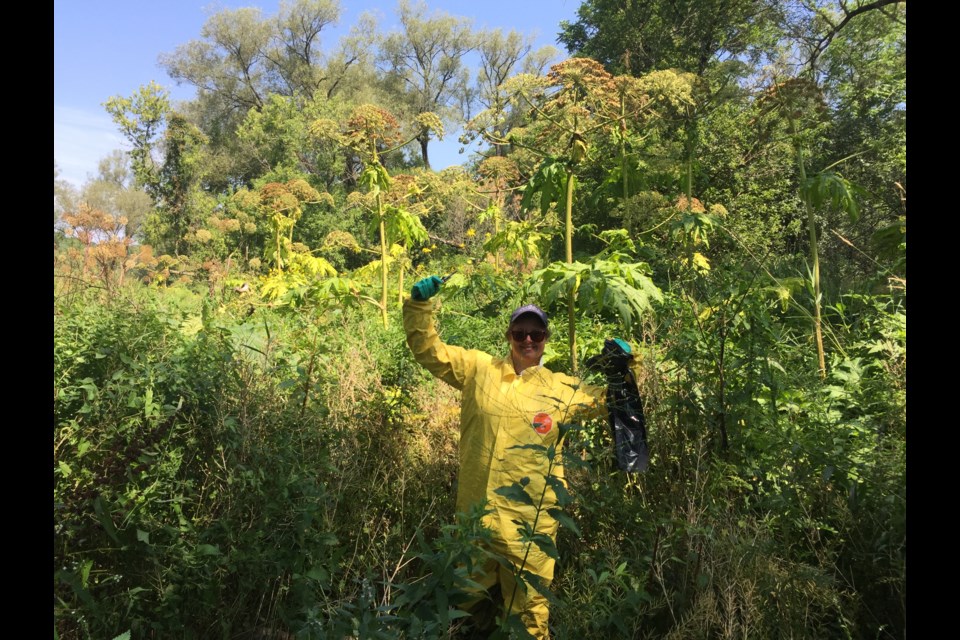A group of local residents is taking on a poisonous plant that lurks in murky, marshy places around the city.
John Kemp, who founded the Giant Hogweed Mitigation Project in 2018, and his fellow volunteers have been tackling the problem of giant hogweed around Cambridge and other areas of Waterloo Region.
He stumbled on the plant when he started looking into edible plants back in 2012.
"When you do that, you have to watch for the poisonous ones," Kemp said. "That's how I discovered (the giant hogweed). We have a large plant that can damage your skin. And since it's bigger than you, it can damage all of your skin. And since you don't know what it is, you don't know to avoid it."
The stems of the plant are covered with reddish-purple flecks and stiff hairs filled with sap, says an online provincial resource on giant hogweed.
The website also effects states of exposure to the sap.
"The clear watery sap of Giant hogweed contains toxins that can cause severe dermatitis (inflammation of the skin)," read the text. "You can get severe burns if you get the sap on your skin and the skin is then exposed to sunlight. Symptoms occur within 48 hours and consist of painful blisters. Purplish scars may form that last for many years."
If someone is exposed to the hogweed sap, the website says, "wash the area well with soap and water. Keep the affected area out of the sun. If photo dermatitis (inflammation of the skin caused by exposure to sunlight) occurs, see a doctor. If you get sap in your eye, flush your eye with water immediately and see a doctor immediately."
Kemp's crew of volunteers has been taking action in the form of educating people about how they can identify the plant, remove it when it's budding in spring, and pitch in later in the year to collect seeds that are destroyed.
"My thrust was to try and encourage more involvement in trying to educate and remove these plants," Kemp said.
And the group has been pretty successful at that, he added.
"We've reached a lot of people in the Grand River watershed and we've managed to remove a lot of the plants in the watershed," Kemp said. "We're not keeping up with the natural growth of the plants but we're at least retarding it. We definitely need more people to participate if we need the river giant hogweed-free."
This crew of volunteers focuses on removing the plants when they begin appearing above ground in spring, he said. That's when people can, wearing gloves and using a shovel, dig them out of the ground, Kemp said.
Once the plant grows to its full bloom — it can grow to 12 feet in height — it's not advisable or easy to pull them out from the root, he said. That's when the focus shifts to making sure the seeds are captured and destroyed, Kemp added.
And that's also when a lot more caution is needed, he said.
"Seed removal requires close contact and that means more protective equipment, so they need to reach out to the group to sign up and receive the equipment and training on how to do it," Kemp said.
Once the seeds are gathered and the plant cut down, the pods and shrubs are put garbage bags and left out in the sun to be destroyed by the heat.
"And then you can dispose of it," Kemp said, adding the group has collected up to 70 pounds worth of plants and seeds on certain days. "That amount won't cook in the sun so it has to be disposed through the municipal landfill for proper disposal."
While his group effort is proactive, Nathan Lantz, Cambridge's supervisor of operations and municipal weed inspector, said the city's approach is more reactive, working based off of resident reports of giant hogweed sightings.
"We've only started finding hogweed plants in the past five years on (municipal) property and along the river," he said. "Once we're aware of areas where we've consistently seen it then we're more proactive in monitoring and removing the plants."
This year, Lantz said, has been the busiest year for legitimate hogweed reports.
"The public has become more aware of it and are able to positively able to identify it a bit better now," he added. "Giant hogweed has umbrella shaped flowers and large single jagged edged leaves."
The way the city tackles the plant is also different than how Kemp and other volunteers go about it.
"The way that we deal with it is that when we identify the areas where the plants are, we will spray them with a legal pesticide and remove the seed heads to eliminate the ability to reproduce," said Lantz. "We tend to spray them to kill off the above ground growth and remove the seed head. The plant will die and then we just monitor the area to make sure there won't be any re-growth."
The city areas where the hogweed has been identified and cleared from, he said, include along the lower portion of Linear Trail as it snakes along the Grand River.
"That's an area we've been monitoring for the past five or six years," Lantz said, adding about a second location. "There is the canoe launch area across from Churchill Park. The city doesn't have resources to go out to the islands in the river and that's where we've been collaborating with John's group because he has volunteers that have the capability to get out to the islands."
Kemp's group can be reached via its Facebook page.



